本科生毕业设计(论文)外文翻译
学 院:
专 业:
班 级:
学 号:
姓 名:
指导教师:
外文翻译
�
关系数据库的结构
关系模型是任何关系数据库管理系统(RDBMS)的基础。一个关系模型有三个重要组成
部分:对象或关系的集合,作用于对象或关系上的操作,以及数据完整性规则。换句话说,
关系数据库有一个存储数据的地方,一种创建和检索数据的方法,以及一种确保数据的逻辑
一致性的方法。
一个关系数据库使用关系或二维表来存储支持某个事物所需的信息。让我们了解一下一
个传统的关系数据库系统的基本组件并学习关系数据库的设计。一旦你对于行、列、表和关
联是什么有了深刻理解,你就能够充分发挥关系数据库的强大功能。
表,行和列
在关系数据库中,一个表是一个用于保存相关信息的二维结构。一个数据库由一个或者
多个相关联的表组成。
表中的一行是一种事物的集合或实例,比如一个员工或发票上的一项。表中的一列包含
了一类信息;而且行列相交点上的数据、字段,就是能够用数据库查询语言检索到的最小片
信息。举个例子来说,一个员工信息表可能有一列,其列名为“LAST_NAME”,列中就包含所
有员工的名字。数据是通过对行、列进行过滤而从表中检索出来的。
主码、数据类型和外码
本篇文章均以假设的斯科特·史密斯的工厂为例,他是数据库的建立者和企业的主办人。
他刚开办了一个饰品公司并目想要使用关系数据库的几项基本功能来管理人力资源部门。
关系:用来保存相关信息的一个二维结构,也就是表。
行:在一个数据库表中的一组单数据或多数据元素,用于描述一个人、地方或事物。
列:列是数据库表的组件,它包含所有行中同名和同类型的所有数据。
你会在下面章节学到如何设计数据库,现在让我们假设数据库大部分己经设计完成并且
有一些表需要被执行。斯科特创建了 EMP 表来保存基本的员工信息,就像这样:
你可能注意到佣金列和管理人列中有一些单元格中没有值;它们是空值。一个关系数据
库能够规定列中的一个单元格是否为空。如此,可以明确那些非销售部的员工佣金单元为空。
同样也明确了公司董事长的管理人单元为空,因为这个员工不需要向任何人汇报工作。
外文翻译
�
单元格:是数据库查询语言所能够检索到的最小片信息。一个单元格就是一个数据库表
的行和列交叉形成的。
另一方面,没有哪个员工的员工编号单元格为空。公司总是希望为每个员工分配一个员
工号,并目这个号码必须是每个员工都不同的。关系数据库的一个特性能够确定某列的键入
值必须为独一无二的。如此,EMPNO 列便是这个表的主码。
主码:主码即是表中的一列(或多列),使每一行能够区别于同表中的其他行。
留意一下 EMP 表中存储的不同数据类型:数值型,字符型或字母型,以及日期型。
你可能会猜测,部门成员列保存的是员工所在部门的编号。但是你如何知道哪个部门名
称对应哪个部门编号呢?斯科特建立了 DEPT 表来具体描述 EMP 表中提到的部门编号的情况。
EMP 表中的部门编号列同 DEPT 表中的部门编号列有着相同的值。既然如此,EMP 表中的
部门编号列便被看作是与 DEPT 表中相同列对应的外码。
外码加强了关系数据库中参照完整性的概念。参照完整性的概念不只可以阻止无效的部
门编号被插入 EMP 表中,而且在某部门仍有员工的情况下,可以防止 DEPT 表中该部门的信
息被删除。
外码:表中的一列(或多列),它的值来自于其他表的主码列或单值列。一个外码有助
于确定表中数据的完整性。
参照完整性:是关系数据库用来加强表间一对多关联的一种方式。
数据建模
在斯科特于数据库中创建真实表之前,他要经过一个称作数据建模的过程。在这个过程
中,数据库创建者定义和填写数据库中所有表。有一种为数据库建模的方式叫作 ERA,它可
以表示出实体、实体间的关联和实体的属性。数据库设计者使用一个能够支持实体、实体属
性和实体间关联的应用程序。通常,一个实体对应数据库中的一个表,而实体的属性对应于
表中的列。
数据建模:一个定义实体、实体属性和实体间关联的过程,从而为建立物理数据库做准备。
数据建模过程包括定义实体、定义实体间关联以及定义每个实体的属性的过程。一旦一
个周期完成,就需要不断重复直到设计者抓住了重点,足以开始建立数据库。让我们进一步
了解为数据库建模过程的步骤。
定义实体
外文翻译
�
首先,设计者确定数据库应用程序范围内的所有实体。实体是人、地方或事物,它们对
于整个团体是重要的且需要被记录在数据库中。实体将被巧妙的转化为数据表。比如,在第
一版斯科特饰品公司数据库中,他定义了四个实体:员工、部门、工资水平和奖金。它们将
称为 EMP(员工)表,DEPT(部门)表,SALGRADE(工资水平)表和 BONUS(奖金)表。
定义实体间的关联
一旦定义了实体,设计者就能够继续定义每个实体间是如何关联的。通常,设计者通常
将每个实体同其他实体配对,并目考虑:“两者之间是否存在关联呢?”实体间的某些关联
是明显的,某些不是。
在饰品公司数据库中,员工实体和部门实体间极可能存在关联,而依据事物间的关系原
则,部门实体跟工资水平实体间似乎就没有关联了。如果事物间的关系原则是用来约束某个
部门的工资水平的,就可能需要一个新的实体来说明工资水平和部门之间的关联。这个实体
被称作关系表或交表,其中包含工资水平和部门之间的有效联合。
关系表:是一个数据库表,其中保存着另外两个表的行(记录)间的有效结合,并且通
常强调了事物间的关系原则。关联表处理的是一个多对多关联。
通常,关系数据库间有二种关联方式:
·一对多关联:最常见的关联是一对多关联。意思是对于每个给出的现有实体(即父实
体)都有一个或多个现有的另一个实体(即子实体)与之相关联。举个例子来说,在饰品公
司数据库中,部门实体是一个父实体,而每个部门中,都有一个或多个员工属于该部门。这
样,部门实体和员工实体间的关联就是一对多关联。
·一对一关联:在一个一对一关联中,表中的一行只关联另一个表中的一行甚至 0 行。
这种关联类型通常用于子类型数据中。例如,一个员工表可能保存了所有员工的信息,而全
职表、兼职表和承包人表则分别保存全职员工、兼职员工和承包人的信息。这些实体被认为
是员工表的子表,并目同员工表维持一对一关联。这种关系不像一对多关联那么常见,因为
如果一个实体与另一个实体总有对应行,在大多数情况下,两个实体中的属性只在一个实体
内出现就可以了。
·多对多关联:在多对多关联中,表的一行可能对应另一个表的许多行,反之亦然。通
常,当这些关联在数据库中被执行时,往往再定义第三个实体用来保存前两个实体间的所有
关联。例如,在一个学籍注册数据库中,学生表与班级表之间有一个多对多关联——一个学
生可能听一门或多门课程,并目一个班级也可能有一个或多个学生。而学生_班级关系表中
就包含了学生和班级之间的关系,以表明哪个学生在哪个班。
指定实体属性
一旦设计者定义了实体间关联,下一步就是去指定每个实体的属性。这是实现列的使用,
如右图所示由工资水平实体所建立的工资水平表。
外文翻译
�
重复步骤:我们仍然在原地
在定义了实体、关联以及属性之后,设计者往往要多重复几次数据建模过程。当我们在
回顾关联时,就会发现需要建立新的实体。比如,当讨论饰品库存表和与它相关的客户订单
时,就会发现需要制定一个送货约束表。
一旦设计过程完成,下面将要建立实际的数据库表。逻辑数据库的设计过程不会牵涉实
际执行中的问题。然而,一旦设计进入到实际的运作,数据库管理员就会很快让设计者从理
想回到现实中来。结果,设计就可能需要再次构想以求得理想的数据库存运行与预算和进度
之间的平衡。
外文翻译
�
附件:外文资料原文
The relational model
Structure of the Relational database
is the basis for any relational database management system
(RDBMS).A relational model has three core components: a collection of objects or relations,
operators that act on the objects or relations, and data integrity methods. In other words, it has a
place to store the data, a way to create and retrieve the data, and a way to make sure that the data
is logically consistent.
A relational database uses relations, or two-dimensional tables, to store the information
needed to support a business. Let's go over the basic components of a traditional relational
database system and look at how a relational database is designed. Once you have a solid
understanding of what rows, columns, tables, and relationships are, you'll be well on your way to
leveraging the power of a relational database.
Tables, Row, and Columns
A table in a relational database, alternatively known as a relation, is a two-dimensional
structure used to hold related information. A database consists of one or more related tables.
A row in a table is a collection or instance of one thing, such as one employee or one line
item on an invoice. A column contains all the information of a single type, and the piece of data at
the intersection of a row and a column, a field, is the smallest piece of information that can be
retrieved with the database's query language. For example, a table with information about
employees might have a column called LAST_NAME that contains all of the employees' last
names. Data is retrieved from a table by filtering on both the row and the column.
Primary Keys, Datatypes, and Foreign Keys
The examples throughout this article will focus on the hypothetical work of Scott Smith,
database developer and entrepreneur. He just started a new widget company and wants to
implement a few of the basic business functions using the relational database to manage his
Human Resources (HR) department.
Relation: A two-dimensional structure used to hold related information, also known as a
table.
Row:A group of one or more data elements in a database table that describes a person, place,
or thing.
Column:The component of a database table that contains all of the data of the same name and
type across all rows.
You'll learn about database design in the following sections, but let's assume for the moment
外文翻译
�
that the majority of the database design is completed and some tables need to be implemented.
Scott creates the EMP table to hold the basic employee information, and it looks something like
this:
Notice that some fields in the Commission (COMM) and Manager (MGR) columns do
not contain a value; they are blank. A relational database can enforce the rule that fields in a
column may or may not be empty. In this case, it makes sense for an employee who is not in the
Sales department to have a blank Commission field. It also makes sense for the president of the
company to have a blank Manager field, since that employee doesn't report to anyone.
Field:The smallest piece of information that can be retrieved by the database query language.
A field is found at the intersection of a row and a column in a database table.
On the other hand, none of the fields in the Employee Number(EMPNO)column are blank.
The company always wants to assign an employee number to an employee, and that number must
be different for each employee. One of the features of a relational database is that it can ensure
that a value is entered into this column and that it is unique. The EMPNO column, in this case, is
the primary key of the table.
Primary Key:A column ( or columns ) in a table that makes the row in the table
distinguishable from every other row in the same table.
Notice the different datatypes that are stored in the EMP table: numeric values, character or
alphabetic values, and date values.
As you might suspect, the DEPTNO column contains the department number for the
employee. But how do you know what department name is associated with what number? Scott
created the DEPT table to hold the descriptions for the department codes in the EMP table.
外文翻译
�
The DEPTNO column in the EMP table contains the same values as the DEPTNO column in
the DEPT table. In this case, the DEPTNO column in the EMP table is considered a foreign key to
the same column in the DEPT table.
A foreign key enforces the concept of referential integrity in a relational database. The
concept of referential integrity not only prevents an invalid department number from being
inserted into the EMP table, but it also prevents a row in the DEPT table from being deleted if
there are employees still assigned to that department.
Foreign Key:A column (or columns) in a table that draws its values from a primary or
unique key column in another table. A foreign key assists in ensuring the data integrity of a table.
IntegrityA method employed by a relational database system that enforces
Referential
one-to-many relationships between tables.
Data Modeling
Before Scott created the actual tables in the database, he went through a design process
known as data modeling. In this process, the developer conceptualizes and documents all the
tables for the database. One of the common methods for modeling a database is called ERA,
which stands for entities, relationships, and attributes. The database designer uses an application
that can maintain entities, their attributes, and their relationships. In general, an entity corresponds
to a table in the database, and the attributes of the entity correspond to columns of the table.
Data Modeling:A process of defining the entities, attributes, and relationships between the
entities in preparation for creating the physical database.
The data-modeling process involves defining the entities, defining the relationships between
those entities, and then defining the attributes for each of the entities. Once a cycle is complete, it
is repeated as many times as necessary to ensure that the designer is capturing what is important
enough to go into the database. Let's take a closer look at each step in the data-modeling process.
Defining the Entities
the designer
identifies all of
First,
the database
application.The entities are the persons, places, or things that are important to the organization and
the entities within the scope of
外文翻译
�

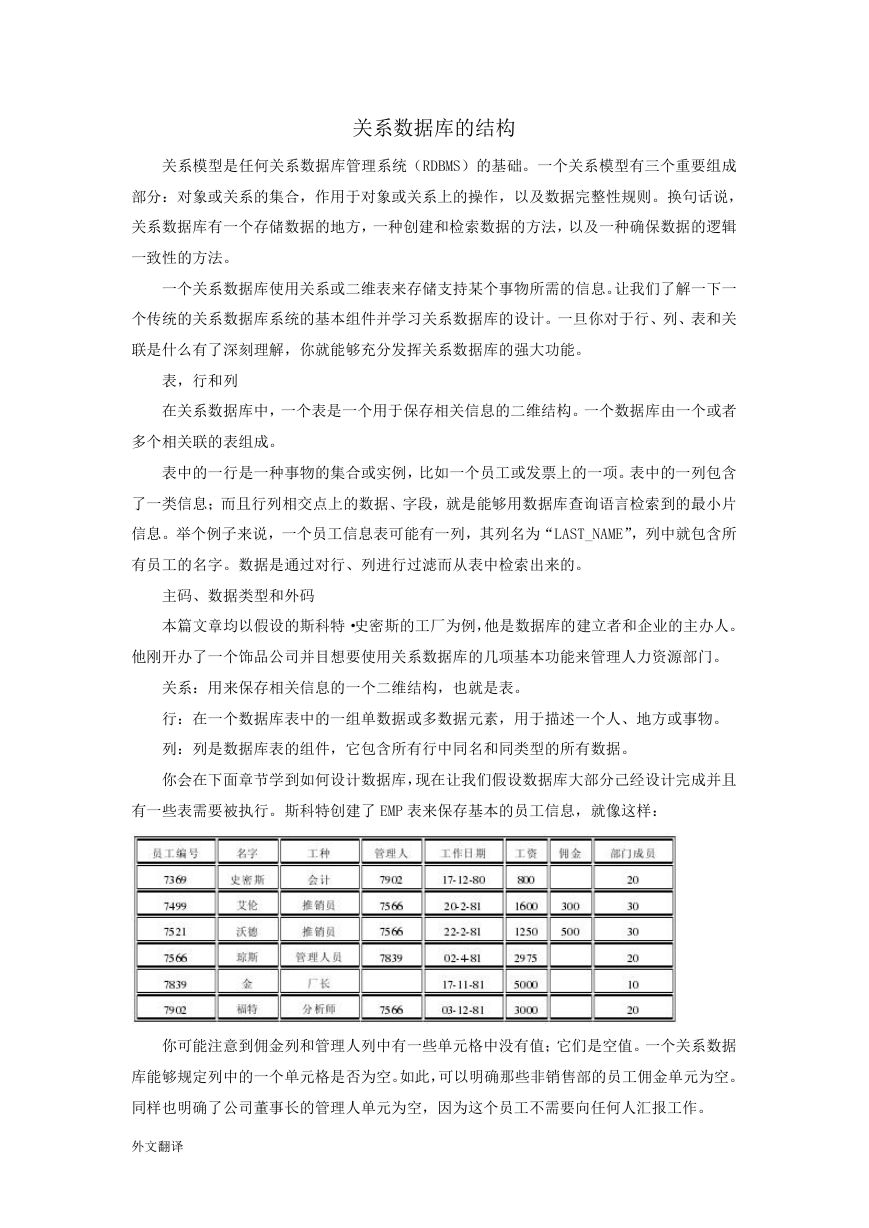

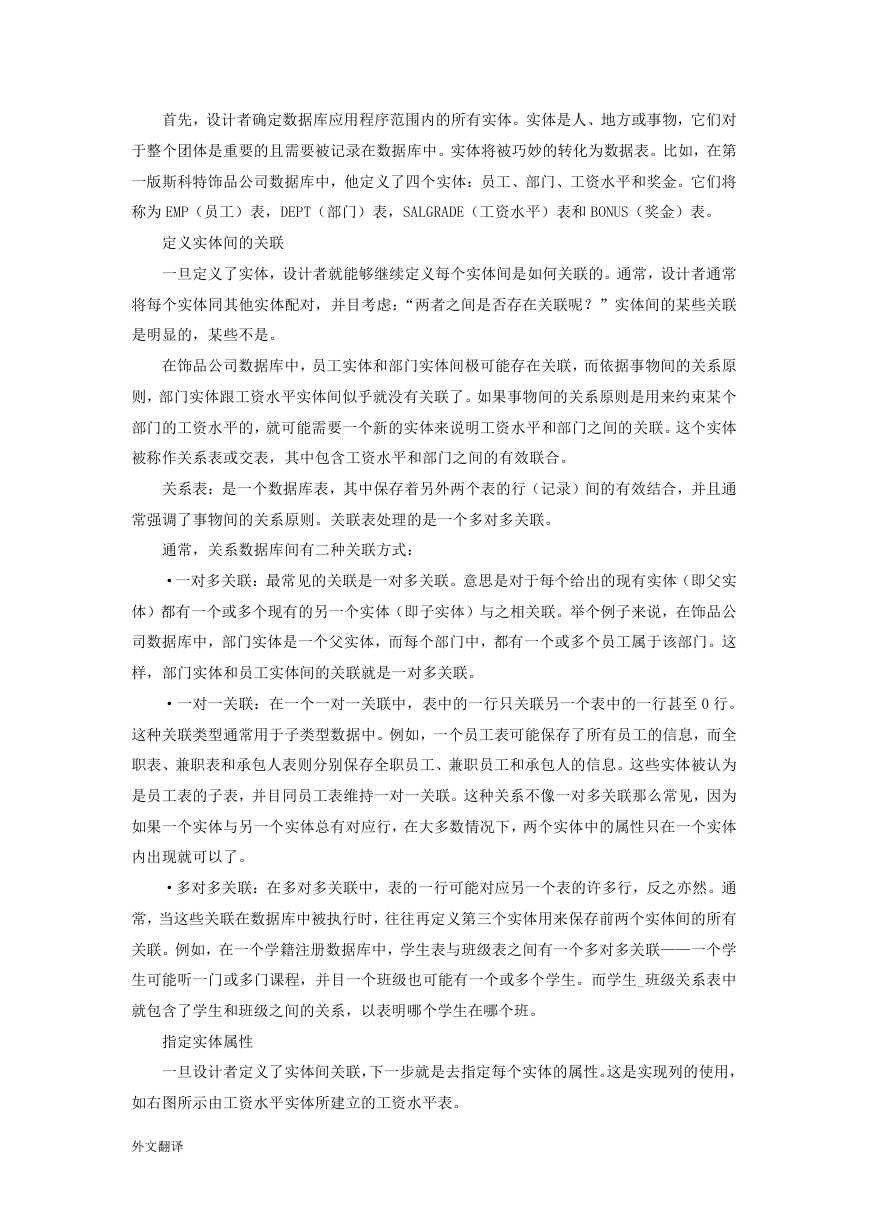
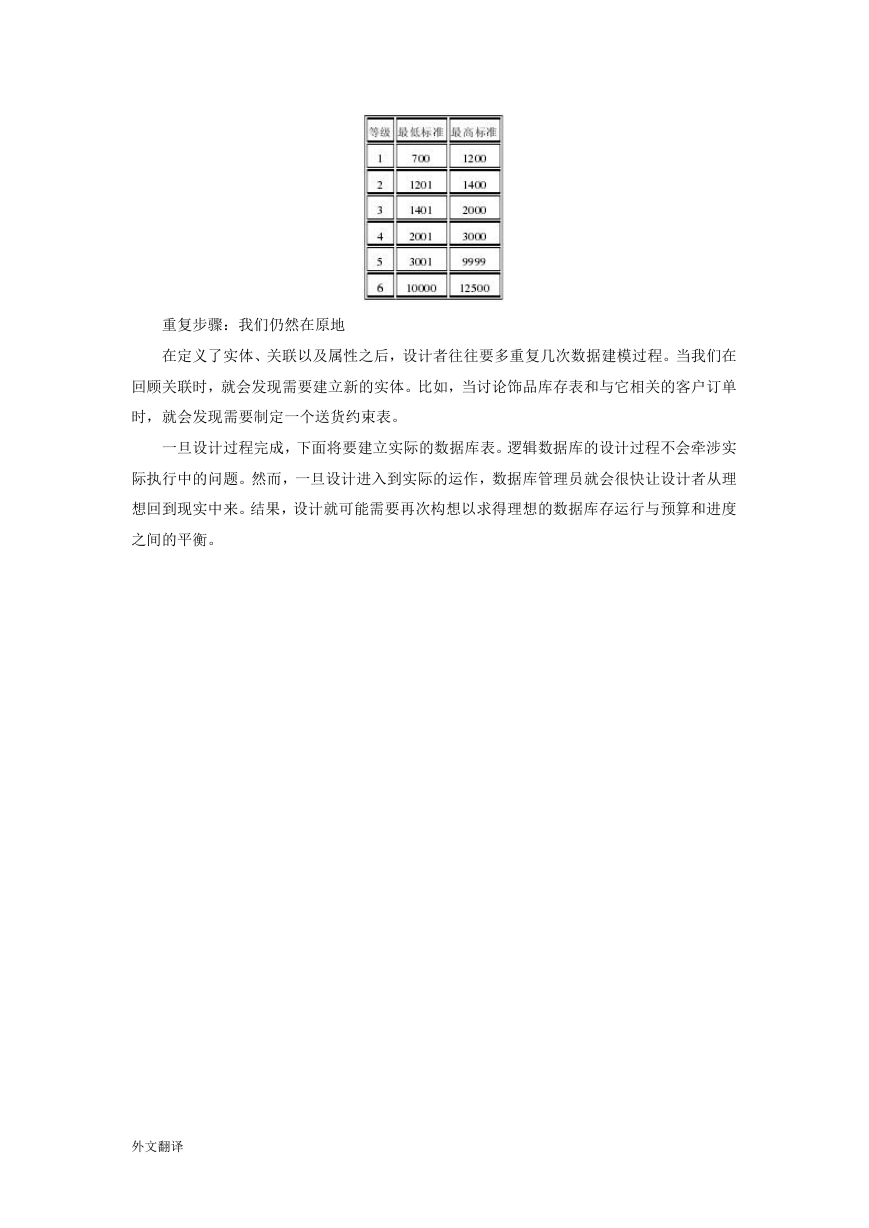
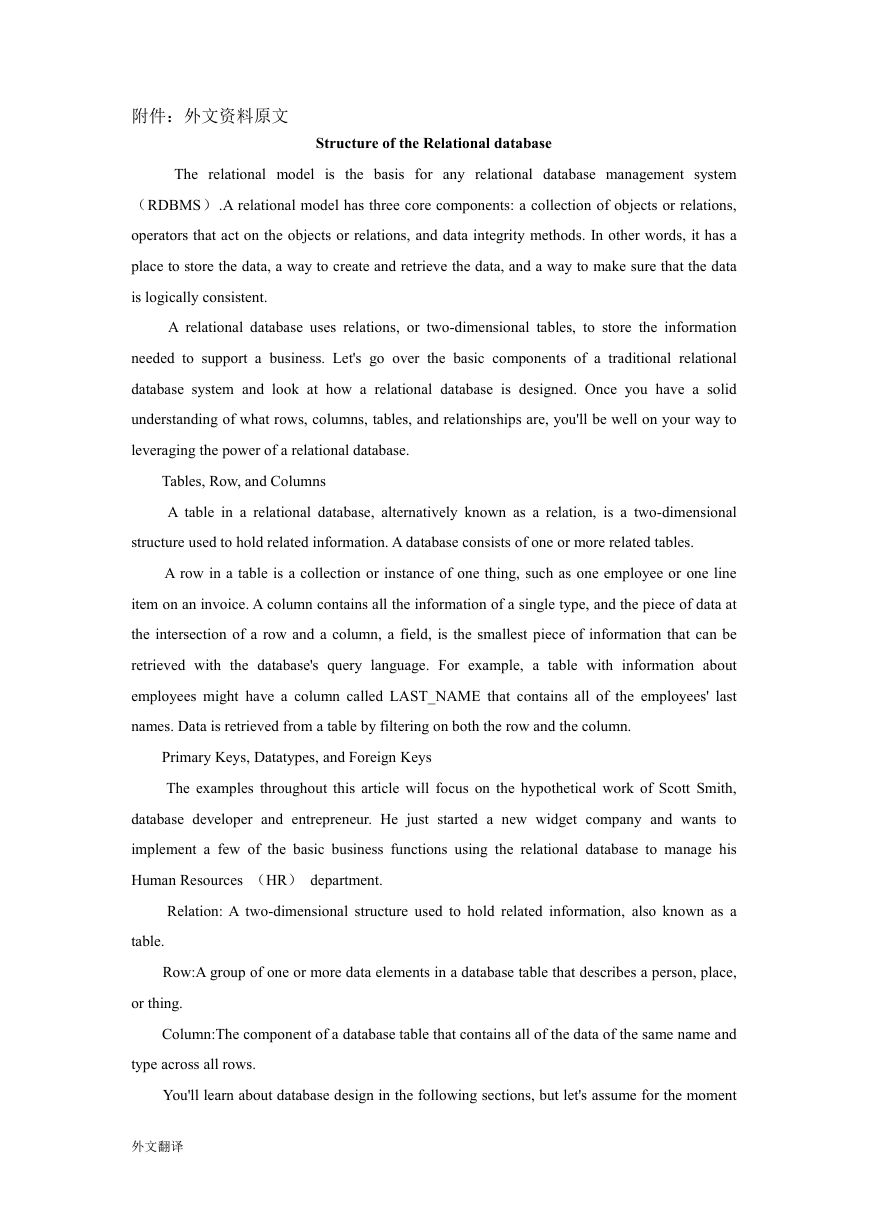

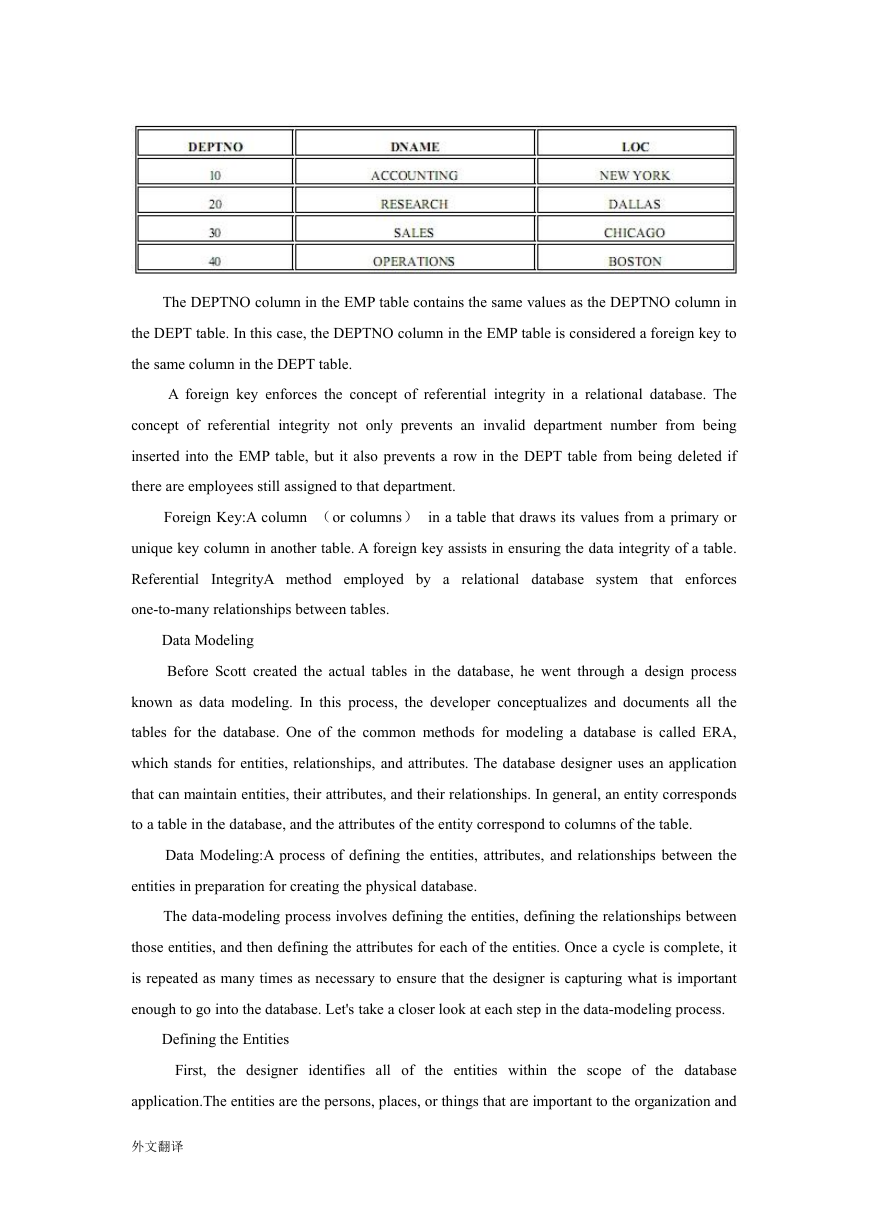








 2023年江西萍乡中考道德与法治真题及答案.doc
2023年江西萍乡中考道德与法治真题及答案.doc 2012年重庆南川中考生物真题及答案.doc
2012年重庆南川中考生物真题及答案.doc 2013年江西师范大学地理学综合及文艺理论基础考研真题.doc
2013年江西师范大学地理学综合及文艺理论基础考研真题.doc 2020年四川甘孜小升初语文真题及答案I卷.doc
2020年四川甘孜小升初语文真题及答案I卷.doc 2020年注册岩土工程师专业基础考试真题及答案.doc
2020年注册岩土工程师专业基础考试真题及答案.doc 2023-2024学年福建省厦门市九年级上学期数学月考试题及答案.doc
2023-2024学年福建省厦门市九年级上学期数学月考试题及答案.doc 2021-2022学年辽宁省沈阳市大东区九年级上学期语文期末试题及答案.doc
2021-2022学年辽宁省沈阳市大东区九年级上学期语文期末试题及答案.doc 2022-2023学年北京东城区初三第一学期物理期末试卷及答案.doc
2022-2023学年北京东城区初三第一学期物理期末试卷及答案.doc 2018上半年江西教师资格初中地理学科知识与教学能力真题及答案.doc
2018上半年江西教师资格初中地理学科知识与教学能力真题及答案.doc 2012年河北国家公务员申论考试真题及答案-省级.doc
2012年河北国家公务员申论考试真题及答案-省级.doc 2020-2021学年江苏省扬州市江都区邵樊片九年级上学期数学第一次质量检测试题及答案.doc
2020-2021学年江苏省扬州市江都区邵樊片九年级上学期数学第一次质量检测试题及答案.doc 2022下半年黑龙江教师资格证中学综合素质真题及答案.doc
2022下半年黑龙江教师资格证中学综合素质真题及答案.doc